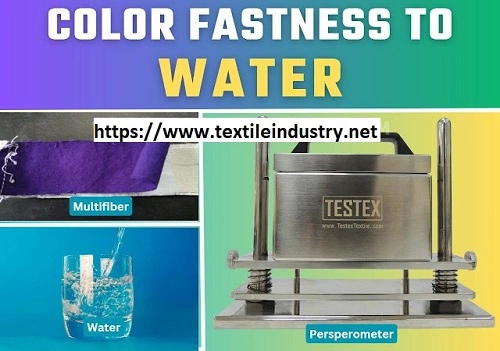This test measures the ability of a material or product to resist bleeding or fading of color when exposed to water, such as during washing or rainy weather. Colorfastness to water refers to the ability of a material to retain its color without fading or bleeding when exposed to water. It is an important quality characteristic of textiles, clothing, and other materials that are likely to come into contact with water during use or cleaning. In this article, we explain the details of the Colorfastness Test on Water in the ISO 105-E01 in the Test Method.
Colorfastness to water is usually measured using a standardized test method, such as the AATCC 107-2017 or ISO 105-E01:2013 test method. In these tests, a sample of material is immersed in water for a specified period of time, and the degree of color fading or bleeding is assessed either visually or mechanically.

What Is Color Fastness To Water?
A textile’s resistance to water-based fading is referred to as color fastness. It is a metric of how well a fabric or clothing retains its hue when exposed to moisture, be it through washing or in-use conditions.
To measure the colorfastness of a material when exposed to water, it must go through a set of tests that emulate the conditions it would encounter if worn or used in wet environments. This can range from washing and soaking to even spraying. Evaluations are then conducted to ascertain how much the dye has changed, bled, and graded by a specified scale. A higher rate of color fastness is preferred for materials likely to be used or worn when in contact with water, such as swimwear, rainwear, or any type of clothing worn outside. In the textile industry, it is essential to consider color fastness to ensure the fabric or garment will stay in excellent condition for a prolonged period.
ColorFastness To Water Testing Method
To determine the resistance of the color of textiles to immersion in water according to ISO 105-E01, Water color fastness measures the water resistance of dyed, printed, or otherwise colored yarns and fabrics. The test method by which this test is performed is AATCC 107-1991 or ISO 105 E01. This method estimates the degree of cross-staining that can occur when clothing is left in contact when moist. The test measures the water resistance of any colored garments.
Equipments Need
- Perspirometer
- Acrylic-resin or glass plates
- Flat-bottomed dishes
- Oven, maintained at (37 +2)°CC
- Light box with light source D65
- Grey scale for assessing change in color (ISO 105-A02)
- Grey scale for assessing staining (ISO 105-A03)
- Distilled water, grade 3
- Multifiber adjacent fabric, type DW (ISO 105-F10)
Test Specimen
One specimen for each color and material measuring 4 cm x 10 cm. All products and parts of a product including details such as labels, badges and drawstrings need to be tested. Both solid and multi-colored products need to be tested. If the product is multi-colored, make sure all colors are included in the specimen to be tested. More specimens might be required if the specimen is printed, striped or have multiple colours. Different parts in contrast colors need to be tested, both against each other and against the multifiber. Cut specimens of all colors and stitch them together face side to face side If face and back side are different in color or construction, both face and back side needs to be tested. If sample is all over printed and backside is strong colored and visible at face side, no need to test back side against multifiber. (No need to test light colored backsides either.If details (including prints) are in contrast color they need to be tested both against multifiber and the fabric of which the detail is attached. If not in contrast color they need to be tested only against multifiber.
Method & Procedure
- 1. Cut a specimens measuring 4cm x 10cm.
- 2. Attach a specimen to multifiber of the same size, by sewing along one of the shorter (4 cm) sides. The
multifiber should be next to the face side. - 3. Switch on the oven and preheat the test device (perspirometer) for 30 minutes.
- 4.. Place the specimens in a dish with 100 ml distilled water and thoroughly wet specimen and multifiber for 30 minutes. (Do not stick the sample with the glass rod, but stir the water to make it thoroughly wet.)
- 5. Pour off the water.
- 6. Place each specimen between two glass or acrylic plates and place them in the perspirometer. Each
Perspirometer can hold a maximum 10 samples. If less, all 11 plates still have to be placed in the perspirometer. Put a pressure of 12.5 kPa on the Perspirometer using the load, lock it and then remove the load. - 7. Place the perspirometer in the oven for 4 hours at (37*C In upright position.
- 8. Take out the specimens from the oven and perspirometer. 9. Open out each specimen and dry them in room temperature, not exceeding 60°C, with the specimen only being in contact at the point of the stitching.
Result
Assess cross staining, change in color and color staining. Note- When assessing the staining of different parts of contrast-colored products or products with contrast-colored details, this should be considered as a cross staining.
I am sure that this information must have been very important for you; if you do not understand anything, then you can ask us by commenting. Friends, if you have liked this post, then share this information with your friends so that they, too can understand this information.


